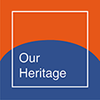Our Heritage Timeline
Covenanters

Covenanters
Opposition to Catholicism had become widespread in Scotland, and in the mid-16th century, John Knox founded a reformed Church of Scotland, Presbyterian in structure and Calvinist in doctrine.
A Presbyterian Church is governed by representative assemblies of elders. Calvinism emphasises the sovereignty of God and the authority of the Bible.
In 1633 Charles I came to St Giles Cathedral in Edinburgh for his Scottish coronation service. The Anglican Church style service was conducted by William Laud, the Archbishop of Canterbury. Charles I felt that Anglican Church style services should be introduced in Scotland and had The Book of Common Prayer printed.
The Anglican Church was Episcopalian which meant it was governed by bishops.
The Book of Common Prayer was first used in St Giles Cathedral on 23 July 1637. When James Hannay, Dean of Edinburgh, began reading from the prayer book, Jenny Geddes threw her stool at the Minister’s head, shouting:
“De’il gie you colic, the wame o’ ye, fause thief; daur ye say Mass in my lug?”
Others threw Bibles, stools etc leading to a riot which spilled out to the street. Rioting in other towns followed and there was a call for the withdrawal of The Book of Common Prayer. King Charles I refused.
In 1885 a plaque was laid in the floor of St Giles to mark what is believed to be the spot from which Jenny Geddes threw her stool. The plaque reads: 'Constant oral tradition affirms that near this spot a brave Scotch woman Janet Geddes on the 23 July 1637 struck the first blow in the great struggle for freedom of conscience which after a conflict of half a century ended in the establishment of civil and religious liberty.'
THE NATIONAL COVENANT
In February 1638 the National Covenant was drawn up. It was a document pledging resistance to the changes being made by Charles I.
Copies of the Covenant were circulated and thousands of people signed. An original copy is on display in Blair Castle, Blair Atholl, Perthshire. It is thought to be the one carried by the Marquis of Montrose to collect signatures.
Charles I tried to impose his authority by military means, leading to the Bishop’s Wars of 1639 and 1640. There followed the First English Civil War in 1642. Defeat in the Second English Civil War resulted in the execution of Charles I in January 1649.
In February 1649 Charles II was proclaimed King of Scotland and Great Britain. By 1651 the Covenanters recognised him as King and in return Charles II signed the Covenant.
However, attempts to impose Episcopalianism in the Church of Scotland continued and by 1661 churches were again governed by bishops. James Sharp became Archbishop of St Andrews and Robert Leighton became Archbishop of Dunblane.
Heavy fines were imposed on ministers who failed to attend government approved church services. Non-conforming ministers were turned out of their church and homes.
CONVENTICLES
The Covenanters held secret meetings in the open air called Conventicles. Government troops tried to enforce the church law and stop these illegal meetings.
Despite the danger, hundreds of worshippers would meet in secret locations with lookout sentries posted to warn of the approach of Government soldiers.
THE BATTLE OF RULLION GREEN
On 28 November 1666 a Covenanter army was defeated by Government forces at Rullion Green, near the Pentland Hills in Midlothian. Between 40 and 50 Covenanters were killed and up to 85 prisoners taken, many of whom were alleged to have been tortured.
Thirty-six were executed and others were transported to Barbados to work as slaves in the plantations.
MURDER OF ARCHBISHOP JAMES SHARP
James Sharp, Archbishop of St Andrews was attacked and murdered by a group of Covenanters on 3 May 1679. The murder sparked a wider uprising which became known as The Killing Time.
THE BATTLE OF DRUMCLOG
On 1 June 1679 Government forces led by John Graham of Claverhouse fought the Covenanters led by William Clelland at Drumclog, near Strathaven, Lanarkshire. This resulted in a victory for the Covenanters, but their success was short lived.
THE BATTLE OF BOTHWELL BRIDGE
The Covenanters established their camp on the south bank of the River Clyde, north of Hamilton. They numbered around 6000 men. Among them were Donald Cargill, William Clelland (the victor of Drumclog), and David Hackston of Rathillet and John Balfour of Kinloch, who were in the group who murdered Archbishop James Sharp.
The Government army was commanded by Charles II’s son James, Duke of Monmouth.
The battle centred on the narrow bridge across the Clyde. Hackston led the defence of the bridge with some initial success, but, due to a lack of artillery and ammunition, after around an hour, the Covenanters were forced to concede defeat. There were many deaths.
Around 1200 Covenanters were taken prisoner and held in Greyfriars Kirkyard Prison in Edinburgh for several months pending trial. They survived due to the charity of the townspeople who provided them with food and drink. Some were subsequently executed in the Grassmarket.
Others gained their freedom by swearing allegiance to the Crown. More than 250 were condemned to slavery and put on board a ship, The Crown of London, at Leith, sailing for the American plantations. During a storm, the ship sank between the mainland and the Orkneys, with the loss of over 200 lives. In 1888 a Covenanters' Memorial was erected at Deerness.
It is estimated that 18000 people lost their lives for adhering to the cause of the Covenant. Many Covenanters who died are revered as martyrs for their faith. Many monuments in many parts of Scotland are dedicated to those who died for their firm religious beliefs.
https://en.wikipedia.org/wiki/John_Knox
https://en.wikipedia.org/wiki/Jenny_Geddes
https://www.orkney.com/news/covenanters-memorial
For information on the murder of Archbishop James Sharp read “Murder on Magus Moor” in “The Real Macbeth and Other Stories from Scottish History” by Maurice Fleming.
Previous Page
